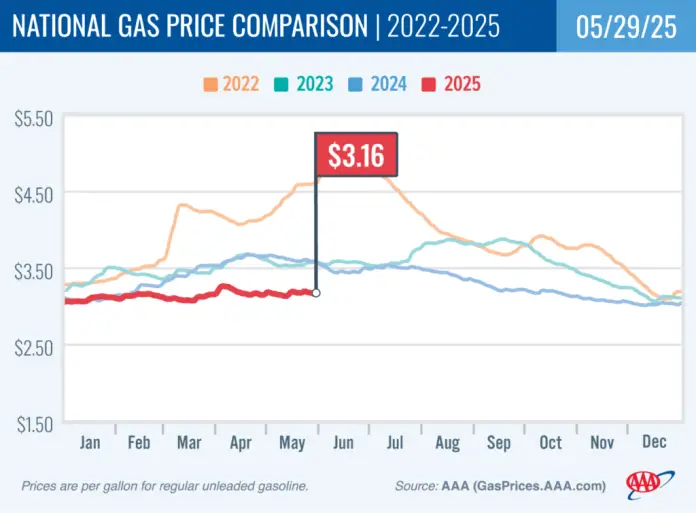As summer approaches, small business owners across the country are gearing up for a season often marked by increased travel and logistics demands. Recent trends in fuel pricing offer both relief and cautionary notes for those managing operational costs. Fuel prices have seen a slight decrease, currently averaging $3.16 nationally, down 3 cents from last week and stabilizing from a month ago. For many small enterprises, this dip in fuel costs presents an opportunity for improved budgeting and cash flow management as the warmer weather ushers in higher demands for goods and services.
The weekly average has seen a noticeable drop from last year’s price of $3.57, forming the backdrop of a summer that could be more affordable for consumers and businesses alike. “Drivers are reaping the benefits at the pump,” according to a recent data release by AAA. This decrease comes amid crude oil prices hovering in the low $60 range, but concerns linger as the Atlantic hurricane season arrives, posing potential challenges. The National Oceanic and Atmospheric Administration (NOAA) forecasts a 60% chance of an above-normal hurricane season, creating uncertainty that could disrupt supply chains and impact fuel pricing.
Crucially for small businesses, the historic fluctuations in fuel prices mean that negotiation with suppliers and transportation partners is vital. Understanding current trends can aid in forecasting costs. In practical terms, businesses relying on delivery services or transportation might find recent prices favorable for operational budgets, especially when coupled with increased gasoline production which has jumped to an average of 9.8 million barrels per day.
Moreover, strategies like optimizing delivery routes or switching to more fuel-efficient transportation options can yield significant savings during this period of fluctuating prices. The latest figures from the Energy Information Administration highlight a clear uptick in gasoline demand—rising from 8.64 million barrels per day last week to 9.45 million this week. This surge hints at increased consumer activity, a plus for businesses in retail and service sectors.
There’s a broader context at play as well, particularly with the growing adoption of electric vehicles (EVs). Although electric charging prices have remained steady at an average of 36 cents per kilowatt-hour, the disparity across states can influence decisions for businesses looking to migrate to EV solutions. For instance, regions like Kansas and Missouri offer some of the most affordable charging, whereas states like Alaska and West Virginia feature notably higher rates. This variance could be crucial for businesses considering fleet upgrades.
Risks remain, however, particularly with potential storm impacts on Gulf Coast refineries which might lead to sudden price hikes. Such volatility is a critical point for small business owners to monitor as they plan for the summer months. Understanding state-specific fuel prices can also help businesses strategize operational costs more effectively. For example, while California tops the list with an average of $4.81 per gallon, states like Mississippi and Louisiana provide significantly lower averages of $2.65 and $2.72, respectively.
Business owners must remain vigilant about external factors influencing both gasoline and electric prices. Keeping a close eye on weather forecasts and energy reports can provide advanced notice of potential disruptions. Furthermore, utilizing tools like the AAA TripTik Travel Planner can assist in finding the most cost-effective routes and charging options.
As more Americans hit the roads for summer travel, the implications of fuel prices extend beyond mere cents at the pump. They can affect everything from goods pricing to service rates, and understanding these trends is essential for sustainable planning. Whether it means adjusting operational calendars or bolstering financial predictions, the current fuel pricing landscape offers both opportunities and challenges as small business owners navigate through a pivotal season.
For more detailed insights on fuel prices, visit the original source here.
Image Via Gas Price



